|
|
Comus

|
|
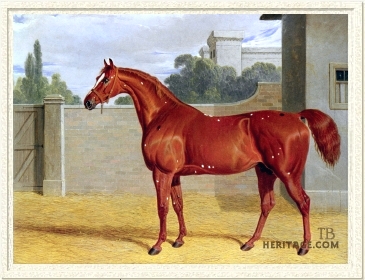 |
|
|
Comus was a strikingly-marked chestnut son of the champion sire Sorcerer. Although he was not among his sire's best offspring on the turf, he sired four classic winners, and more significantly, got a big, hulking son -- Humphrey Clinker -- who, despite being as mediocre on the race course as his sire, also managed to get a couple of classic winners and a son, Melbourne, an influential sire who ensured the continuance of the Godolphin Arabian sire line.
Comus' dam, the bay Houghton Lass (1801), was a daughter of Derby winner Sir Peter, sire of nine classic winners and nine-time leading sire in Great Britain. She showed reasonably good form during her three years on the turf, placing second in the Oatlands Handicap at Newmarket twice, at age 3 and again at age 6, beating some very good horses, including Quiz, Orville, Parasol, and Miss Coiner during the course of her career. She was purchased after her racing career by Sir John Shelley of Maresfield Hall, Sussex, who bred eleven foals from her before selling her, around age 20, to Ireland, where she produced two more. In addition to Comus, her second foal, she produced Caliban (1810) and Calypso (1816), both fair race horses by Sorcerer; the Prix de Diane winner of 1845, Suavita, descended tail-female from Calpyso. Another daughter, Parthenope (1814), extended the family into the early twentieth century; from her descended Irish Derby winner Madeira (1865) and Hungarian crack Obertas (1918).
His sire, the black Sorcerer, was a good, fast race horse in-bred to Matchem 3 x 3. He did not contest the classics, but later beat the 1798 Derby winner, Sir Harry, several times. He won at all distances, up to four and one-half miles. He became an influential sire, three times leading the lists, with seven classic winners, some classic-producing daughters, and good sire sons, the best of which was Comus, whose male line descendants sustained the Godolphin Arabian sire line.
Comus was born in 1809 at Shelley's Maresfield Park in Sussex. He was a bright chestnut whose coat was amply flecked with white and black spots. It is possible he was the source of what are now known as "Bend Or" spots; Marigold, the dam of Bend Or's sire, Doncaster, had two lines back to Comus in the fifth generation. He stood somewhere between 15.2 and 16 hands, depending on which stud ad can be believed, and possessed a temper, which he passed on to most of his stock.
Comus on the Turf
His racing career was moderately successful over two seasons, and he was a versatile winner of distances between five furlongs and two miles.
He won the goodly amount of 3,550 guineas total in eight matches and sweeps at Newmarket during his three year old year. He won a produce sweepstakes at Newmarket in his first outing in March at Newmarket, beating seven others, and at Newmarket First Spring took a 100 guines sweepstakes, beating Bdokin and Ptolemy. Also at that meeting he was second in a 200 guineas sweepstakes to a gelding by Beningbrough. He was favored for the Derby of 1812, which had been won the previous year by Shelley's Walton colt, Phantom. He ran third to Octavius and a colt by Gohanna in a field of fourteen. At Ascot he was third to Elizabeth and Pointers in a 100 guineas sweepstakes, with five others in the field, and on the same day won a 100 guineas sweepstakes, beating five. In the fall he came out at Newmarket First October to win a 200 guineas sweepstakes, beating Cato, Woful, and three others, and ran second to the filly Elizabeth in a Thousand Guineas Stakes at Newmarket Second October, with Joe Miller and two others behind him. At Newmarket Houghton he won a 200 guineas match against Pointers.
In his second season he won thre races. At Newmarket in April he won a fifty subscription purse, beating eight, and at Newmarket First Spring took the Claret Stakes, beating Cato, Cwrw, and Historia. His last win was a sweepstakes worth 100 guineas, also at Newmarket First Spring, where he beat four others.
Comus in the Stud
He stood his first season in 1814 at Bedale in Yorkshire, for 10 guineas, attracing mares of sufficient quality to make him an instant success. In 1815 he was at Newmarket, and the following year sent back to Yorkshire where he stood at Mr. Haw's farm at Morton, near Northallerton. In 1819 his services were offered from a base at Ledston Hall Farm, the farm of his owner, Christopher Wilson, near Ferrybridge, Yorkshire, and his fee had risen from 10 guineas in 1814, to 15 guineas--by then, his sons had placed 1-2-3 in the 1818 St. Leger. Between 1822 and 1828 he alternately stood at Ledston Hall and Six-Mile Cottage near Newmarket, but his fee had been reduced to £10. In 1829 he was back at the Ridsdale farm in Murton, near York, and then was back at Ledston Hall. In 1832 his fee had fallen to £6. He eventually ended up at the Sykes' Sledmere Stud, near Driffield, in east Yorkshire.
His first crop of seventeen foals, sixteen of which were colts, included Reveller, Ranter, and The Marshal, winner, place and show respectively, in the twenty-one horse field of the 1818 Doncaster St. Leger, the first two owned by Henry Pierse of Bedale, Yorkshire. In addition to Reveller, he sired three other classic winners -- 1,000 Guineas winner Catgut (1816), the great race filly Matilda (1824, St. Leger), and 2,000 Guineas winner Grey Momus (1835). He got some other top race horses, and proved to be a good broodmare sire, as well. While his son, Humphrey Clinker, ensured the continuance of the Godolphin Arabian sire line, his daughters established strong tail-female lines leading to such horses as Cyllene, Prince Chevalier, Magnat, Isonomy, Star Shoot, and Northern Dancer.
|
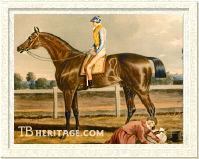
Reveller
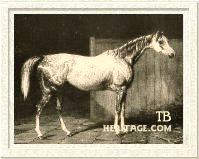
Grey Momus
| |
REVELLER was one of Comus' two best racing sons. He was born in 1815, out of Rosette, a good racing Beingbrough mare in Henry Peirse's Bedale, Yorkshire, stud. Prior to his St. Leger triumph for Peirse, he won a 900 guineas produce stakes at York, beating Cambyses and five others. His other win that year was a walk-over for the Gascoigne Stakes. His other big wins during his six years of racing were the Doncaster Stakes (three times), the Lincoln Cup, the Lancaster Gold Cup, the York Great Subscription Purse in August (twice), and the Preston Cup, in which he defeated the virtual perennial winner of that race, the aging Dr. Syntax. One of his few defeats was to another Comus son, The Juggler, in the Second Great Subscription Purse race at York in 1820.
Reveller was retired to the stud in 1823, and got a number of good winners, among them Rioter, Bosphorus, and 1,000 Guineas winner Galantine.
GREY MOMUS was conceived and born in 1835, at the other end of Comus' long career as a sire, at the Sledmere stud of Sir Tatton Sykes -- where Comus, by then blind, with eyes "white as an egg," stood. He was out of a Sykes -bred, short-legged mare by Cervantes. He was sold to Doncaster tarvern owner Mr. Bowe, and was later sold to Lord George Bentinck.
|
| Grey Momus had a heavy schedule at age two under trainer John Day, winning twice -- the Lavant Stakes and the Molecomb Stakes -- in his five starts, and placing second once. At age 3, he won the 2,000 Guineas, leading from the start, and went on to win a 300 sovereign match race two days later. He ran third for the Derby, but bounced back to win the prestigious Ascot Gold Cup, the Drawing Room Stakes at Goodwood, the Racing Stakes, and the Grand Duke Michael Stakes. At age 4 he won the Port Stakes at Newmarket, and two more races, then failed to place at Ascot and Cheltenham, and broke down in a race at Guildford. He stood at stud for a while at Sledmere, and later was exported to Germany. |

|
The Comus son destined to continue the Godolphin Arabian sire line was the golden yellow bay HUMPHREY CLINKER, out of Clinkerina, a daughter of the very modest Sir Peter son, Clinker, and Pewet, a good race mare who had won the 1789 Doncaster St. Leger. He was bred by William Wentworth Fitzwilliam, Earl Fitzwilliam, who also raced him, limiting the horse's challenges to Yorkshire venues that nonetheless included some stiff competition. HUMPHREY CLINKER was described as a horse "of immense size and power, unquestionably the largest thoroughbred ever known." He also "made a bit of noise," or as The Druid put it, "he did prophesy of himself pretty loudly as he came up to the cords," which may have affected his racing career.
Although fast, HUMPHREY CLINKER was not a top race horse. At age three he won a produce sweepstakes at Pontrefact, beating two, and was second to Saladin in Doncaster's Foal Stakes. His best year was 1826, when he was four. He won York's Constitution Stakes, beating Lottery and three others, and the Knavesmire Stakes, beating two. At Doncaster he won a handicap sweepstakes, beating one, and a produce sweepstakes beating Escape, Saladin, and one other, but could only run third in a thrilling Doncaster Gold Cup, to the great race mare Fleur-de-Lis and to Mulatto (also owned by Fitzwilliam); the latter would win the same race the next year. In 1827 he won Malton's Craven Stakes, beating five, and then was third to Fleur-de-Lis and Jerry in York's Constitution Stakes. He won six races total during his career. |
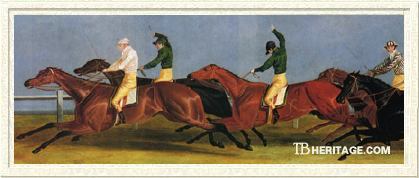
Humphrey Clinker finishing third to Fleur-de-Lis and Mulatto in the 1826 Doncaster Cup. |
HUMPHREY CLINKER was retired to the Earl's stud at Wentworth Lodge, near Rotherham, Yorkshire, in 1828. A year later the Earl sent him to William Allen's stud at the Lodge in Malton, (north) Yorkshire, where he stood for for a year, and where he got Rockingham (1830) for Allen. Fitzwilliam then sent Humphrey Clinker to County Wicklow, Ireland for three years, where there were vast Fitzwilliam estates, and where he got two good horses, BRAN and Famine, both for Lord Sligo.
Rockingham won the Doncaster St. Leger and the Doncaster Gold Cup at age 3, and went on to three more years of good wins, including the Goodwood Cup. He died young, leaving relatively few offspring. Famine ran in England, where he was moderately successful, winning at secondary venues; he beat Rockingham at Lewes for a King's Plate over two and one-half mile heats in 1834. Bran, a handsome chestnut of 1831 was sent to run in England after debuting at age 2 at the Curragh. He won the York St. Leger, the Gascoigne Stakes, and several other races at age 3, and ran second in the Doncaster St. Leger (1834) and the Ascot Gold Cup (1835). In the stud, Bran got the Oaks winner Our Nell, and a number of good hunters and steeplechasers.
In 1833 HUMPHREY CLINKER was brought back to England; the Earl gave him to William Allen, who, in addition to running his breeding establishment, served as an agent for the Earl at his Malton and other northern estates. He made two seasons at Malton, dying in June of 1834 after "...having been allowed to eat a large quantity of tares, by which he became swollen, and had no passage for the same. Being possessed of that temper common to all the stock of Comus, he would not permit a stranger to approach him; and thus the difficulty of operating for his relief." In his first season back in England, he got Melbourne, who was born in 1834, the year of his sire's death, and who became the very successful progenitor of the Godolphin Arabian sire line, twice leading sire in England. |

|
Other Comus sons who ran well included the aforementioned THE JUGGLER, like Reveller, a member of Comus' first crop, who won the Doncaster Cup in 1820. IDERIM (1822), a bay colt out of the Walton daughter, Promise, won the Ascot Gold Cup in 1825. FLEANCE (1822) was also a winner at Newmarket against top company.
Comus daughters were also successful on the turf, and many proved to be good producers. |
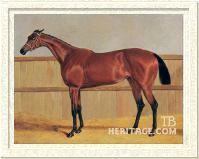
Matilda
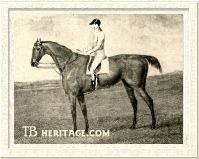
Isabella
| |
MATILDA, born in Yorkshire in 1824, was out of Juliana, by Gohanna, who also produced Woodcote Stakes winner Lady Foot (1817, by Reubens). Bred by Edward Petre at his Stapleton Park stud in Yorkshire, she was a small, attractive filly with a "very fidgety disposition."
At age two she won a sweep against colts and fillies, followed by another 500 sovereign sweep against both sexes in which she was never headed. At age three, she ran twice, first winning a £380 sweep at York, and then the Doncaster St. Leger, beating Mameluke and other top horses. Her St. Leger win was eventually comemmorated at Stapleton Park, where she retired to stud, in the form of the "Matilda Clock," located over the stables there.
She ran four times at age 4, placing second in the Constitution Stakes at York, third in the Great Subscription Purse at York, second in the Richmond Cup, and finally, in the running for the Northallerton Cup, she "bolted clean out of the Course, and did not start again."
Matilda was retired to the Duke of Cleveland's stud, a gift from Petre, where she produced some good runners, among them Champagne Stakes winner Eliza. A descendant of her unnamed daughter by Whiskey, Nat, won the Cambridgeshire Handicap Stakes in the mid-nineteenth century.
|
ISABELLA, a bay filly of 1820, out of Shepherdess, a mare by Shuttle, ran for two years, winning the Sapling Stakes at York in her first outing at age 3, although not placing in any of her other three attempts, which included being withdrawn from the false start of the 1823 St. Leger, having, with 15 other horses, run the entire course before the race was re-run. At age four she ran in secondary venues, primarily, and won very well at two and three miles, her victories including the Cup Stakes at Beccles, the Town Plate, the Chelmsford Gold Cup, the Huntingdon Cup, the Gold Cup at Northampton, and at Newmarket a 100 sovereign match against Cephalus. In 1825 she won the Gold Cup at Northampton again, the Gold cup at Swaftham, and races, usually over two or more miles, at Chelmsford, Ipswich, and Beccles. She did not produce anything of note in the stud.
CATGUT, a brown filly out of Vanity, was born in the Duke of Grafton's stud in 1816. She won her first outing, the 1,000 Guineas, in 1819, but failed to place in the Oaks. She also did not produce much of signficance in the stud.
Comus daughters who were immediate successes as producers included an unnamed daughter from Marciana (by Stamford). To Waverley in 1835 she foaled DON JOHN, the best three year old of his generation, who won the Champagne Stakes, the Doncaster St. Leger, and the Doncaster Cup among other races. A few years later she dropped HETMAN PLATOFF (1836) to Brutandorf, who was a great weight-carrier and winner of the Liverpool St. Leger and the Northumberland Plate, among other races. Her daughter by Peter Lely established her own branch of Family 2 (2-w), from whom descended 2,000 Guineas winner Disraeli, Doncaster Cup winner Hungerford, French Derby and Grand Prix de Paris winner Magister, and a number of stakes winners in various countries, including six Italian Derby winners.
A grey Comus daughter of 1816, out of a mare by Delpini, produced St. Leger winner NUTWITH (1840, by Tomboy), and another good horse, the grey COLCHICUM (1836, by Physician), who won the Manchester Cup. From her grey daughter, Miss Lydia (1838, by Belshazarr), descend a host of top horses in tail-female, principally through her granddaughter, Maid of Masham (1845, by Don John), who won the Great Yorkshire Stakes. This is Family 9 - e and its subsidiary branches, and includes such horses as Boussac-bred classic winners descending from Astronomie (Arbar, Asmena, Caracalla, Marsyas and the like); Cyllene; Yentoi; Fairy Gold and her progeny -- including Fair Play; Star Shoot and his half-sister, French Oaks winner Saint Astra, ancestress of such horses as Asterus and Prince Chevalier.
ELIZA LEEDS (1817), out of the Hambletonian mare, Helen (1811), produced a good son in ERYMUS (1827, by Moses), who won a number of races, including the Woodcote Park Stakes and the Oatlands, and ran second in the St. Leger. Her daughter, Eva (1832, by Sultan), produced the French 2,000 Guineas winner Giges. Her family (2 -t ) bred on through her daughter, Pergama (1836, by Priam), producing numerous stakes winners in central Europe.
MY LADY (Family 8 - k) produced Delphine (1825, by Whisker). Delphine , winner of the Richmond Cup and the Northallerton Cup for Edward Petre, was later purchased by King George IV, and in the Hampton Court Stud produced Monarch, purchased for $1,280 as a yearling and sent to America by his new owner, Wade Hampton II of South Carolina, where he was an unbeaten race horse and later had a long, successful career at stud. Delphine's daughter, The Queen and son, Herald, a good race horse in the U.S., were also sent to the U.S.
WOODBINE produced a son by Whisker, also named Whisker, who was purchased as a yearling to Australia. There, he was almost unbeaten in Sydney, and got one of Australia's most famous early runners, the gelded Jorrocks (1833), winner of 65 races from 95 starts.
PRUNELLA (1833), from a mare by Partisan (Family 1-f), was sent to the U.S., where she produced Belmont (1847) to American Boy. Belmont ended up in California, where he got many tough, versatile horses, including the great race mare Miami, defeated only once in her long career, who was dam of the top race horse Nathan Coombs.
Many Comus daughters established long-lived female lines from which top horses emerged, some of which are noted here. The unnamed full sister to Grey Momus (1834) was ancestress of Cesarewitch and Gold Cup winner Lecturer and German Derby winner Pirat. Another unnamed daughter of 1836 (Family 5-g) had a great-grandaughter, Lady Lumley who was the tail-female ancestress of some top American and French horses, including Twenty Grand, Kentucky Derby winners Sir Huon and Elwood, Washington D.C. International Stakes winners Run the Gantlet and Fisherman, French Derby winner Hours After and Italian Derby winner Zaizoom, to name but a few. Another unnamed daughter of Comus (1834), out of Emma by Don Cossack (Family 2-d) was the tail-female source of the great stallion Hurry On (1913), and Spectacular Bid (1976), and through a far distant female descendant, American Futurity Stakes winner Mother Goose (1922), ancestress of of that great series of Almahoud daughters, Cosmah (dam of Tosmah, Halo, and Queen Sucrree), Natalma, dam of Northern Dancer, and Bubbling Beauty, dam of Arctic Tern. Madame Vestris (1818), a Comus daughter from Hambletonian mare Lisette (Family 19-b) established a long-lived and successful female line with such descendants as Grand National winner Tipperary Tim (1918); 2,000 Guineas winner and sire Vedette (1854); Epsom Derby winner Sir Hugo (1889); Arc de Triomphe winners Sica Boy (1951) and Tony Bin (1983), and numerous other stakes winners in a multitude of countries. Comus daughter Euphrosyne (1819), from a mare by Shuttle, was the tail-female source of the great racehorse and sire Isonomy (1872), and a number of other good winners.
Comus, who went blind after a bout of fever, lived to the age of 28, and was breeding mares well into his twenties. The Druid said "He filled the Sledmere pastures with dozens of white-legged chestnuts; but Sir Tatton never had anything by him nearly so perfect as Grey Momus." Comus was shot in 1837, the continued succession of the Godolphin Arabian sire line already assured by his grandson, Melbourne.
--Patricia Erigero |
|
|
|

